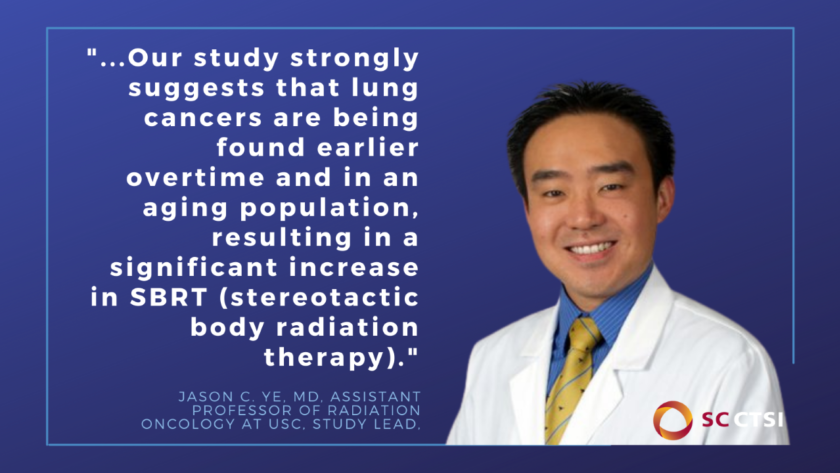SC CTSI researcher collaborates with USC team to understand patient choices in cancer treatment

Over nearly two decades, more and more patients have chosen stereotactic body radiation therapy (SBRT) as an alternative to surgery for certain kinds of early-stage lung cancer. SBRT deploys innovative techniques to target and deliver high levels of focused radiation doses to tumors. Even so, surgery remains the standard of care. So, why are more patients picking this non-surgical method? Are patients who choose SBRT receiving the most appropriate treatment?
In 2010, a prospective trial and other clinical evidence showed that SBRT is effective for lung cancer when caught in the early stage.
“Still, SBRT is a relatively new treatment,” said Li Ding, MD, MPH, a Biostatistician with the Biostatistics, Epidemiology, and Research Design (BERD) group at the University of Southern California Clinical and Translational Science Institute (SC CTSI) and a doctoral student in Biostatistics in the Department of Population and Public Health Sciences at the Keck Medicine of USC. “About a decade ago, treatment guidelines started to promote using SBRT,” she said. “When physicians learned that it was effective from treatment guidelines, they used it more often.”
Ding collaborated on a joint USC-SC CTSI study to understand patterns of SBRT selection by patients and effectiveness in reducing tumor size. The team analyzed data from the National Cancer Database from 202,367 patients. The researchers evaluated patient choice and tumor outcomes from both SBRT and surgery for individuals with early-stage primary non–small cell lung cancer (NSCLC) from 2004 to 2016. The team, led by Jason C. Ye, MD, Assistant Professor of Radiation Oncology at USC, published findings in the April 2022 issue of the American Journal of Clinical Oncology.
“With the rise of popularity of SBRT as a non-invasive alternative to surgery for early-stage NSCLC, there is concern among some physicians that it may be offered inappropriately, particularly in those with larger tumors who may be better served by surgery,” said Ye.
The positive news is that patients’ mean tumor size of early-stage NSCLC decreased over the study period for both SBRT and surgery, according to the study. The probability of patients receiving surgery slightly declined from 58% to 53%. But the use of SBRT increased from 1% to 20%, especially among older patients, those with smaller tumors, and those with significant co-morbidities. This increased use of SBRT contributed to a significant decline in patients who had no therapy from 27% to 16%.
“While we could not determine the treatment decision making at the individual patient level, our study strongly suggests that lung cancers are being found earlier overtime and in an aging population, resulting in a significant increase in SBRT,” Ye added.
“In our study, we wanted to learn whether the recommended treatment guidelines effectively promoted SBRT to physicians as an alternative to surgery for some patients,” said Ding. “Our study’s trend lines support that hypothesis.”
The study reflects the importance of experienced biostatisticians in healthcare research as principal investigators attempt to plumb massive, complex databases for answers to research questions. “These types of large database studies have the advantage of large sample sizes and provide important insight into how ‘everyday’ patients are doing outside of the rigorously controlled clinical trial setting. Li has been an enormous asset, and I feel very fortunate that our collaboration has already resulted in three peer-reviewed manuscripts, with more hopefully on the way,” said Ye.
“When the principal investigators approach me, they usually have a research question and the targeted data set they want to use,” said Ding. “But major databases have many more variables than the PI typically could use, and all have limitations. The principal investigator may not be familiar with the dataset’s structure and variables and nuances of the data collection, while I have years of experience using these databases. I help PIs understand whether a database they have chosen is useful for their purposes or if it has a major limitation. I help them identify the best way to ask a research question and selection of a database that could answer it. I help them design the study and carefully think through all the processes with them, continuing with data exploration and refining the research question to better fit a study cohort, and then doing analysis. Later, I contribute to writing the manuscript.”
Unfortunately, some principal investigators approach Ding for her expertise after they have already done considerable analysis or even after submitting a manuscript.
“At that point, there are times when there is not much we can do to help,” she said. “But if PIs come to us early, we can help them carefully design their projects from the beginning.”



